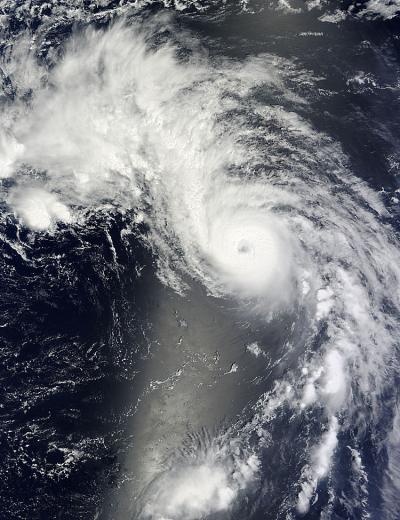Genevieve downgraded to a tropical storm

NASA's Terra satellite captured this image of Typhoon Genevieve on Aug. 9, 2014, at 23:15 UTC. Credit: Image Credit: NASA Goddard MODIS Rapid Response Team
The storm is located approximately 819 nautical miles west-northwest of Midway Island.
It is currently tracking northwestward at 8 knots per hour over the past six hours.
Maximum significant wave height is 32 feet.
Maximum sustained winds 70 knots gusting to 85 knots, with winds of 34 knots or higher occur within 80 to 105 miles of the cente,r and winds of 64 knots or higher occur within 15 miles of the center.
No landmasses are currently threatened by this storm.
Genevieve is moving northwest and has continued to weaken.
Unfavorable environmental factors has caused a rapid weakening over the past 12 hours.
The storm will dissipate within 2-3 days, far southeast of the Aleutian islands.
Text credit: Lynn Jenner
NASA's Goddard Space Flight Center
Media Contact
All latest news from the category: Earth Sciences
Earth Sciences (also referred to as Geosciences), which deals with basic issues surrounding our planet, plays a vital role in the area of energy and raw materials supply.
Earth Sciences comprises subjects such as geology, geography, geological informatics, paleontology, mineralogy, petrography, crystallography, geophysics, geodesy, glaciology, cartography, photogrammetry, meteorology and seismology, early-warning systems, earthquake research and polar research.
Newest articles

Properties of new materials for microchips
… can now be measured well. Reseachers of Delft University of Technology demonstrated measuring performance properties of ultrathin silicon membranes. Making ever smaller and more powerful chips requires new ultrathin…

Floating solar’s potential
… to support sustainable development by addressing climate, water, and energy goals holistically. A new study published this week in Nature Energy raises the potential for floating solar photovoltaics (FPV)…

Skyrmions move at record speeds
… a step towards the computing of the future. An international research team led by scientists from the CNRS1 has discovered that the magnetic nanobubbles2 known as skyrmions can be…




















